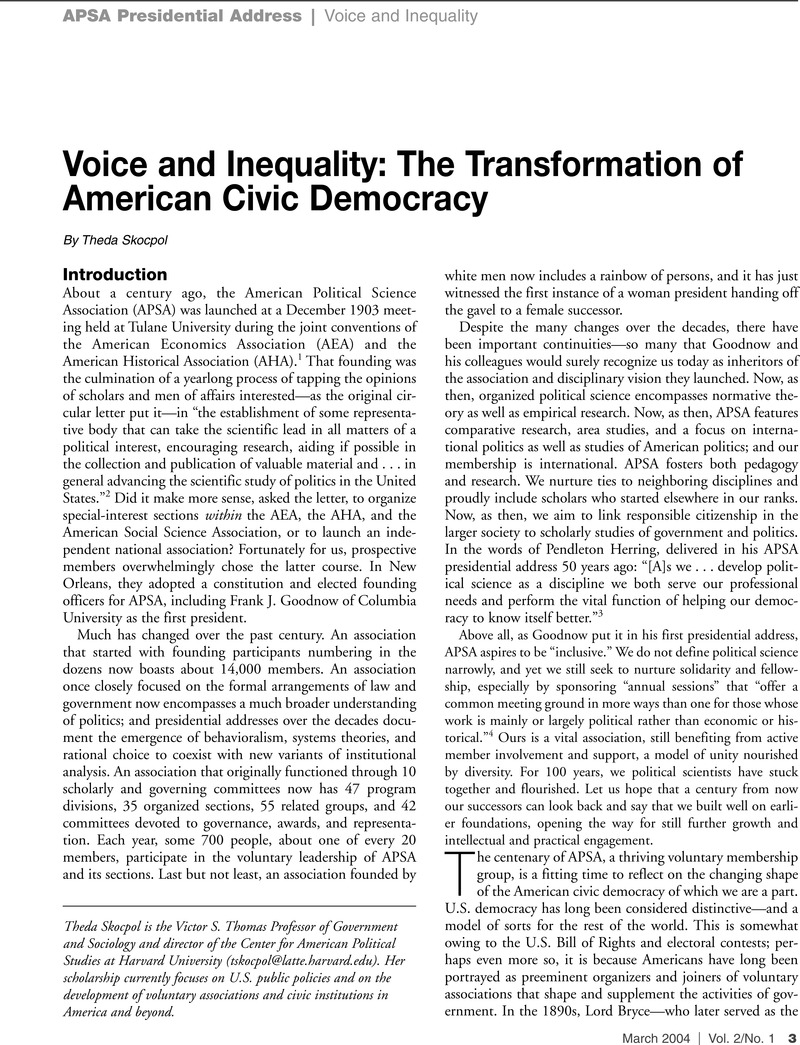Crossref Citations
This article has been cited by the following publications. This list is generated based on data provided by Crossref.
Sampson, Robert J.
McAdam, Doug
MacIndoe, Heather
and
Weffer‐Elizondo, Simón
2005.
Civil Society Reconsidered: The Durable Nature and Community Structure of Collective Civic Action.
American Journal of Sociology,
Vol. 111,
Issue. 3,
p.
673.
Imig, Doug
2006.
Building a Social Movement for America's Children.
Journal of Children and Poverty,
Vol. 12,
Issue. 1,
p.
21.
Jacobs, Lawrence R.
and
Skocpol, Theda
2006.
Restoring the Tradition of Rigor and Relevance to
Political Science.
PS: Political Science & Politics,
Vol. 39,
Issue. 1,
p.
27.
Baldez, Lisa
2007.
Primaries vs. Quotas: Gender and Candidate Nominations in Mexico, 2003.
Latin American Politics and Society,
Vol. 49,
Issue. 03,
p.
69.
Haddad, Mary Alice
2007.
Transformation of Japan's Civil Society Landscape.
Journal of East Asian Studies,
Vol. 7,
Issue. 3,
p.
413.
Grundy, John
and
Smith, Miriam
2007.
Activist knowledges in queer politics1.
Economy and Society,
Vol. 36,
Issue. 2,
p.
294.
Gallego, Aina
2007.
Unequal Political Participation in Europe.
International Journal of Sociology,
Vol. 37,
Issue. 4,
p.
10.
EIMER, THOMAS R.
2008.
Decoding Divergence in Software Regulation: Paradigms, Power Structures, and Institutions in the United States and the European Union.
Governance,
Vol. 21,
Issue. 2,
p.
275.
Swartz, Teresa Toguchi
Blackstone, Amy
Uggen, Christopher
and
McLaughlin, Heather
2009.
Welfare and Citizenship: The Effects of Government Assistance on Young Adults' Civic Participation.
The Sociological Quarterly,
Vol. 50,
Issue. 4,
p.
633.
Kriner, Douglas
and
Shen, Francis
2009.
Limited War and American Political Engagement.
The Journal of Politics,
Vol. 71,
Issue. 4,
p.
1514.
Oser, Jennifer Lynn
2010.
Between Atomistic and Participatory Democracy.
Nonprofit and Voluntary Sector Quarterly,
Vol. 39,
Issue. 3,
p.
429.
Jones Stater, Keely
2010.
How Permeable is the Nonprofit Sector? Linking Resources, Demand, and Government Provision to the Distribution of Organizations Across Nonprofit Mission-Based Fields.
Nonprofit and Voluntary Sector Quarterly,
Vol. 39,
Issue. 4,
p.
674.
Haddad, Mary Alice
2010.
From Undemocratic to Democratic Civil Society: Japan's Volunteer Fire Departments.
The Journal of Asian Studies,
Vol. 69,
Issue. 1,
p.
33.
Bovens, Mark
and
Wille, Anchrit
2010.
The education gap in participation and its political consequences.
Acta Politica,
Vol. 45,
Issue. 4,
p.
393.
Dana, Karam
Barreto, Matt A.
and
Oskooii, Kassra A.R.
2011.
Mosques as American Institutions: Mosque Attendance, Religiosity and Integration into the Political System among American Muslims.
Religions,
Vol. 2,
Issue. 4,
p.
504.
Majic, Samantha
2011.
Serving Sex Workers and Promoting Democratic Engagement: Rethinking Nonprofits' Role in American Civic and Political Life.
Perspectives on Politics,
Vol. 9,
Issue. 4,
p.
821.
Eimer, Thomas R.
and
Philipps, Annika
2011.
Networks hanging loose: the domestic sources of US–EU patent disputes.
Review of International Political Economy,
Vol. 18,
Issue. 4,
p.
460.
Walker, Edward T.
McCarthy, John D.
and
Baumgartner, Frank
2011.
Replacing Members with Managers? Mutualism among Membership and Nonmembership Advocacy Organizations in the United States.
American Journal of Sociology,
Vol. 116,
Issue. 4,
p.
1284.
Tatarchevskiy, Tatiana
2011.
The ‘popular’ culture of internet activism.
New Media & Society,
Vol. 13,
Issue. 2,
p.
297.
Stolle, Dietlind
and
Hooghe, Marc
2011.
SHIFTING INEQUALITIES.
European Societies,
Vol. 13,
Issue. 1,
p.
119.





